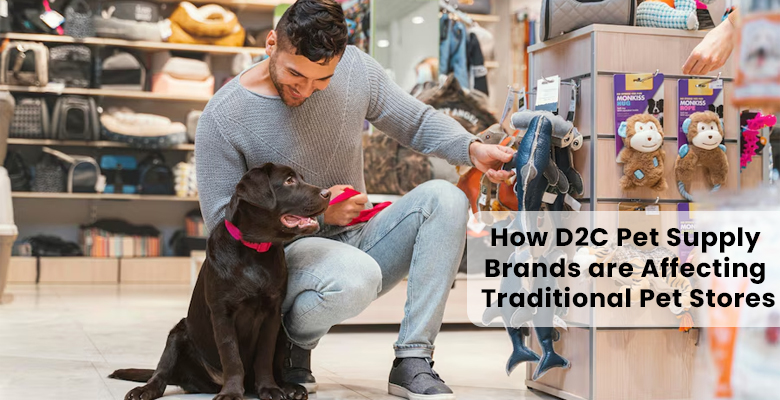
The pet supply industry has changed a lot over the last ten years, mainly due to direct-to-consumer (D2C) brands popping up everywhere. These are the brands that don’t go through traditional retail to sell products. In fact, they go straight to the customer; quite often using the Internet. This change greatly affected the conventional pet stores and changed their whole dynamics, consumer behaviors, and competitive strategies.
The Rise of D2C Pet Supply Brands
New pet supply brands have become the sector’s main parties. They use digital channels to reach pet owners directly and bypass traditional pet stores. Platforms like Heads Up for Tails, Sleepycat, and more have based their concepts on the rising online shopping habit as the primary deciding factor for the consumer.
A report from Grand View Research observed that the valuation of the worldwide pet care market amounted to $207.9 billion in 2020. It is expected to increase at a compound annual growth rate (CAGR) of 6.1% till 2028 (Grand View Research, 2020). This is mainly because of the increase in the online pet supply sector bolstered by the emergence of D2C brands.
Market Dynamics and Consumer Preference
- Pet owners today need better products that are high in quality and class, and D2C brands have taken advantage of this changing trend. Contemporary pet owners are catered for by these brands mainly concentrating on high-quality ingredients, sustainability practices, and custom options. For example, The Farmer’s Dog has a meal plan for each dog based on its dietary requirements; something most conventional pet shops cannot do.
- In a survey carried out in 2021, 39% of pet owners had bought their last pet supply online, as compared to 17% in the year 2015. The change signifies an increasing dependence on e-commerce and a preference for the ease and range provided by direct-to-consumer brands. American Pet Products Association (APPA)
- Currently, there are 20 million pet dogs and 5.5 million domestic cats, giving a total industry value of $900 million.(approximately)
- As is typical of any pet industry, food makes up the majority of it, with a total value of $650 million, or 70% of the total market. As the industry evolves, new businesses and even new cost categories are likely to emerge. Products such as pet insurance are becoming increasingly popular as the number of pets increases, while higher quality and premium food and other pet products become available.
Top Pet Industry Statistics in India
- India is home to approximately 30 million pet dogs. (Statista)
- We have a stray cat population exceeding 9 million. (NCBI)
- There are about 5.5 million pet cats in India. (World Population Review)
- Pet care industry is valued at around $900 million. (Market Decipher)
- The Indian pet food market is projected to reach nearly $650 million by the end of 2024. (Statista)
- The leading platforms in the pet care industry include Heads Up for Tails, Canine India, Just Dogs, Benny’s Bowl, Papa Pawsome, and more. (Market Decipher)
- The dog population in India is expected to grow to 43 million by 2026.
- For over the next decade, this industry is anticipated to experience an annual growth rate of 19%. (Market Decipher)
- The pet services sector in India will reach $0.5 billion by 2025. (Yourstory)
Impact on Traditional Pet Stores
The surge of D2C pet supply brands has put considerable pressure on traditional pet stores. These stores face several challenges, including
Reduced Foot Traffic
Customers are opting for online shopping, which has resulted in reduced footfall at traditional pet stores. This worsened by the COVID-19 pandemic which hastened the movement towards e-commerce.
Competitive Pricing
D2C brands regularly operate through cheaper means than conventional shops enabling them to charge lower prices. This results in some disadvantages especially for conventional pet shops which find themselves unable to match this pricing advantage.
Product Differentiation
In general, D2C companies tend to narrow down their audience and make customized products to meet particular demands. On the other hand, conventional pet shops might have a wider array of items, but they can’t match the same level of popularity concerning certain target groups.
Brand Loyalty and Subscription Models
A lot of D2C brands are using subscription models to retain customers. This guarantees their recurring income, and develop brand devotion among consumers. A case in point is the Chewy auto-ship function which permits pet proprietors to plan regular dispatch of their animal products. This makes it less probable for them to move on to other types or manufacturers.
You can easily buy these products from major platforms like Amazon and Flipkart and avail of huge discounts on every purchase.
Conclusion
The emergence of D2C pet supply brands has greatly changed the landscape of conventional pet shops, threatening their market share hence requiring them to reformulate their strategies. The strength of D2C brands lies in their ease of use and personalized services. Brick-and-mortar stores can use their locations as an advantage over online stores leading towards the creation of different values. Having accepted the digital transition, conventional pet stores can withstand the changes taking place and remain prosperous in the competitive pet supply industry.
